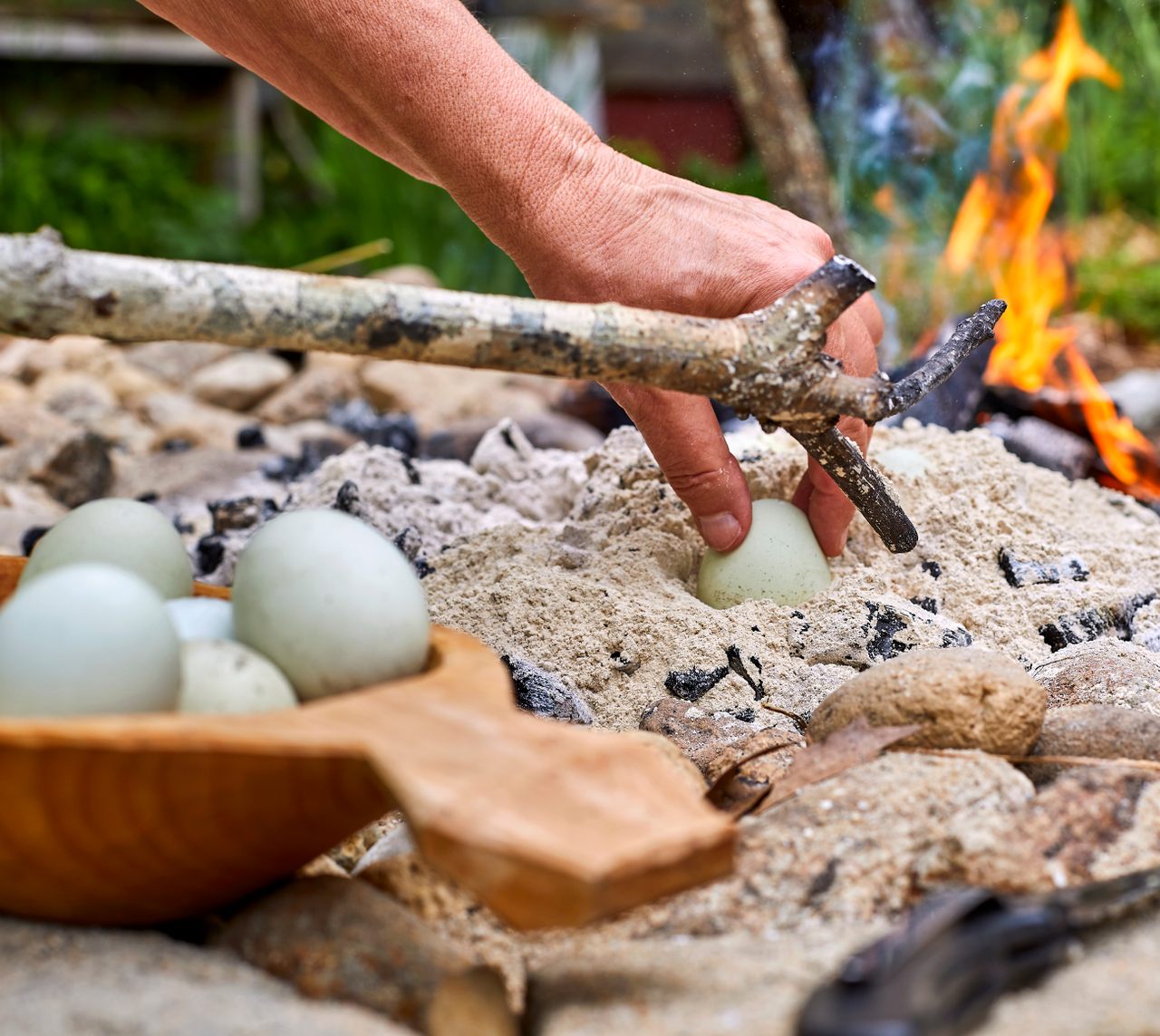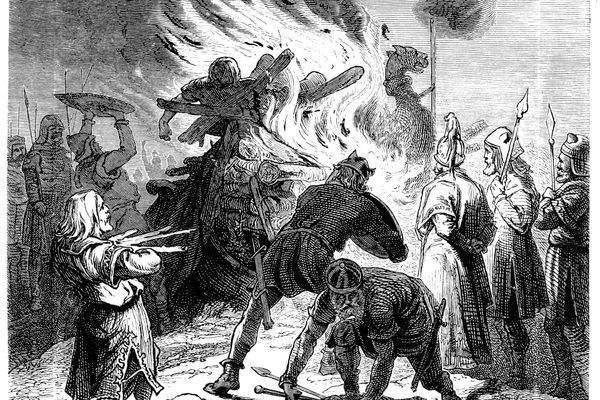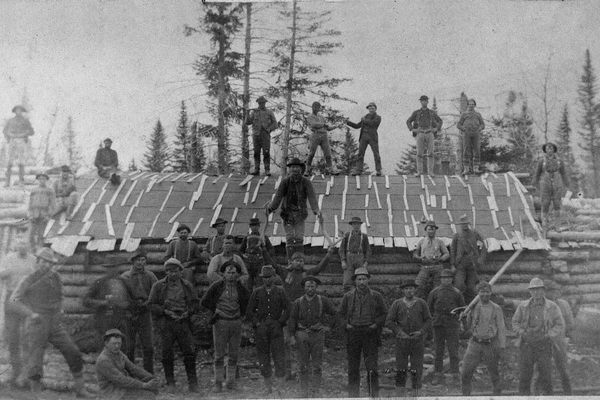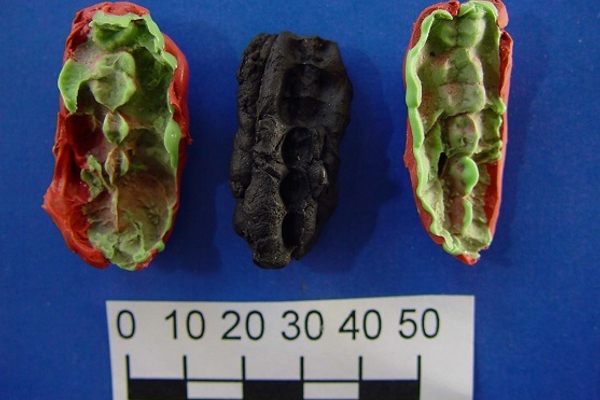The Lost Art of Roasting Eggs in Ash
Even Shakespeare knew the value of a well-roasted egg.
Gastro Obscura’s Summer Cookout columnist Paula Marcoux is a food historian and the author of Cooking With Fire. Throughout the summer, she’s been sharing recipes and stories from the luminous history of open-fire cooking.
“Truly thou art damned: like an ill-roasted egg, all on one side.”
William Shakespeare’s witty fool Touchstone lets this zinger fly in As You Like It, and the food historian senses a challenge. The art of egg-roasting may now be as bygone as an eglantine or a bodkin, but what can be learned of the history and fate of the technique? Furthermore, in defining for us an ill-roasted egg, Touchstone not only proposes a history question, but presents a cooking challenge—to well-roast an egg, evenly, and to taste.
It’s likely that roasting eggs in the dying remains of a fire is one of our earliest human—or even hominin—cooking projects. Many millennia before the domestication of poultry, there were springtime nests of woodpeckers, gulls, and rheas for our forebears to rob. And even before we were exerting reasonable control over fire for cooking purposes—that might be 1.9 million years ago according to a current theory—geothermal heat and wildfire aftermath gave the earliest cooks a chance to experiment.
Could the archaeological record supply technical clues to prehistoric egg-roasting techniques? Although human-modified eggshells—especially those of ostriches—-are common finds from very ancient archaeological sites throughout Africa, researchers have yet to identify remains of eggs that show specific evidence of roasting. Even at a historic site in North America where eggshells were intensively analyzed, discerning the eggs’ cooking method was not part of the study’s aims. So we are, at the moment, out of luck for picking up tips from archaeological sources.

What about documentary evidence? What sources might contain practical instructions as to how to roast an egg? A look through old cookbooks, so often a reliable font of culinary information and inspiration, reveals little on this topic. A broader inquiry into other sorts of documents—such as anthropological texts, classic literature, and personal memoirs—offers more hints at the long, and only recently-faded, run that this technique has enjoyed in the more casual end of the cookery spectrum.
The most familiar context for a roasted egg in modern American life probably occurs during the celebration of Passover, where the small item is invested with quite a lot of symbolic freight—as both a bitter memento of the destruction of the Temple in Jerusalem and as a hopeful springtime token of renewal and redemption. For our current purposes, doesn’t its place in the holiday tradition imply well over two millennia of festive egg-roasting? Unfortunately, the hard fact is that the earliest mention of such a semi-burnt offering on the Seder plate dates to only the 16th century—scarcely earlier than the Shakespeare reference. Even more disappointingly, the rabbinical commentaries that permit the use of ash-roasted eggs in this context are mum on tips and tricks for producing them.
Giving up on early cookbooks and the Talmud, we find a bit more guidance on egg-roasting techniques in travel narratives and personal memoirs. In his account of serving as an English officer in Spain during the Napoleonic Wars, Thomas Boys writes of being rescued from a famished condition by a courteous Spanish muleteer. The kind stranger took an egg, “cracked it at one end, and stuck it upright in the hot embers.” Boys’s verdict? “I beg to state that a roast egg—so roasted, i.e., done slowly in the embers—not only is altogether a different sort of thing from a boiled egg, but beats it to sticks: especially if washed down, as mine were on the present occasion, with a cup or two of good sound Spanish wine out of a leathern bag.”
Boys’s muleteer was not the only character doling out roasted eggs to hungry travelers in 19th-century Europe. Boston minister George Foxcroft Haskins climbed Mount Vesuvius on his Grand Tour of Europe in 1850, and was surprised to discover near the summit “a party of gentlemen in a fissure between two banks of sulphur, roasting eggs in the ashes of the mountain.” After this jolly group of American tourists invited Haskins to join them, they “drank together some mountain wine and ate eggs roasted in the cinders” of the active volcano.
Other Americans writing at home in that same period convey the notion of egg-roasting as the particular province of children, back in a time when a generally low level of supervision empowered kids to learn many practical skills that would horrify parents today. For the curious cook, there’s much to be gleaned from the accounts of these egg-roasting youngsters.

The phenomenon was common enough in America that an educator used egg-roasting to illustrate an abstract concept of physics in his 1837 volume of popular science. Unaware that he would be helping a future audience learn egg-roasting basics, he set out to make the idea of expansion accessible with the following example: “When children roast eggs they crack the shell slightly before they are put into the fire to keep them from exploding or bursting as they usually call it. The egg bursts because the liquid in the shell expands with the heat. If there is a little crack in the shell the steam will find vent and do no injury, but if the vapor is confined, the shell explodes with a loud noise and the egg is scattered through the ashes.”
By the end of the 1800s, egg-roasting had become a nostalgic memory to more privileged and educated Americans, who had moved on to dainty dishes and multi-course fine dining, and whose polished and efficient cast-iron stoves did not permit such idle fun. But at the other end of the wealth scale, egg-roasting continued to be a welcome and nourishing treat requiring no investment in gear. Accounts describe roasting eggs in ash and embers, along with peanuts and sweet potatoes, as late as the 1930s.
Among such families who couldn’t afford to waste eggs through careless explosions, we find descriptions of a roasting technique that swaddles the eggs in wet rags, a practical refinement that would buffer the eggs from excessive heat and contain explosions, promoting higher retrieval rates of roasted egg-shrapnel. Acie Thomas, who was born enslaved in Jefferson County, Florida, in 1857, recalled in an interview done many decades later, that, when he was very small, one of his more pleasant assignments was “ferreting out the nests of stray hens, turkeys, guineas, and geese … to prevent the fowls from hatching too far from the hen house.” A percentage of these renegade eggs “got roasted in remote corners of the plantation by the finders, who built fires and wrapped the eggs in wet rags, and covered them with ashes. When they were done a loud pop announced that fact to the roaster.”
Regardless of the speaker’s socio-economic origin, these oral histories describe egg-roasting in such a gleeful tone that the irresistibility of the method is conveyed across the decades. In the mid-1860s, young James Tubbs would lie in wait for his grandma, at that point not five years a free woman, to depart for church on Sunday mornings. Once she had turned the corner from their Arkansas home, he would pilfer her henhouse for eggs, and “roast ’em and eat ’em” with his friends out back in their “play thicket.” Decades later, at age 72, Tubbs expressed no regret for this crime, or even for its penalty, declaring, “whoee if she didn’t whup us!”
Why, then, if egg-roasting was so much fun, did it fade so totally from our lives? The answer likely lies in the deep cultural shift that took place in idealized mid-century America, with its prosperous gleaming kitchens, convenience foods, and matched-set daintiness; with the corralling of children, the erasure of the grinding Depression years, with the devaluing of Black experiences; and above all, in the intervening decades, with Americans’ loss of confidence and intuition about cooking with fire, loss of tolerance for tasks requiring patience and perspicuity, and loss of the taste for pure ingredients when something processed might be had. The world moved from a place where hungry children foraged for eggs and made their own fire in a hearth or a thicket, to the mainstream one we inhabit, where supervised children haplessly set alight marshmallows impaled on purchased sticks, the very antithesis of the egg-roasting experience.
The wonderful thing, though, is that this kind of fun is still available to anyone—of any age—who cares to accept the unique learning challenge of roasting in ash and embers. Use the guidelines below, gleaned in scraps from sources like these, to see if you can recapture some of the joy—and deliciousness—of this lost technique.
Eggs Roasted in Ash
At their best, ash-roasted eggs have a creamy, yielding texture, with the slightest leathery bite on the exterior that you’ll miss next time you have to settle for a boiled or steamed egg. The flavor seems extra-rich, carrying only the palest wisp of smoke.
Ingredients
Good fresh eggs, a few more than you think you need, since accidents may happen.
A little salt, to accompany. Anything else is a distraction.
Fire
When a recipe calls for but one ingredient, it’s a given that its quality had best be top-notch. But when it comes to egg-roasting, the quality of the ashes is equally critical. You can’t just spark up a fire and expect to roast eggs the way you’d grill a steak—you need a deep bed of puffy hot ashes to hold the eggs upright while buffering them from the dying embers and swathing them in a gentle, almost poaching, heat.
Unless you generate piles of ashes by cooking in a fireplace all day, every day—a commonplace occupation around the world for millennia, but now increasingly a global rarity—the perfect egg-roasting scenario is seldom liable to present itself. Fortunately, when it does—after you’ve burned a big brush pile, say, or had a decent campfire for several hours—the egg-roasting process requires almost no tools or preparation (other than mental) and extends the fun with fire a bit longer.
An indoor fireplace, a fire pit, a beach bonfire, even a chiminea are all great places to roast eggs. Remember, though, that these little eggs are vulnerable to their surroundings so be sure that no toxics have been burned—no paint, no particle board, no accelerants.

Equipment
- If you’re worried about your ability to make just the right crack in the pointy end of your egg, you can use a tool to make the tiniest hole: for example, a very pointy pocket knife, an awl, an ice-pick, or a cork-screw.
- To manipulate the egg: a couple forked sticks, asbestos fingertips, or some tongs if you’re a cheater.
- Zen-mind focus
Practice
It’s recommended to work on your egg-roasting discipline privately before performing for others. I’m ambivalent about the proverb, widespread in early modern Europe: “Fools roast eggs and wise men eat them.” But it’s a good plan to consume a few of your own production before seeking out other diners, regardless of their wisdom level.
Technique
Egg-roasting calls for the very last remains of a fire, with plenty of lovely ash, as discussed above. A few pointers to help create this situation:
- Ash is created by burning hardwoods, even just sticks; pine, cedar, and so on provide plenty of combustion but do not contribute much to the all-important fund of ashes. Choose oak, ash, maple, beech, birch, and even willow.
- As a large campfire is reduced to embers, use a long shovel to manipulate the remains to your advantage. You can simply concentrate them in one spot, then wait for them to simmer down to ashes.
- Or— shovel as many ashes and embers as you can into another, smaller locus, away from the lingering blast of the fire.
- Or—use the shovel or tongs to remove any remaining burning wood, leaving the coals and embers, buried in ash, behind.
- If you have a chiminea, this is a great culinary use for it. Same rules for creating the ash bed, but you get a little extra help from the oven-like atmosphere within the chiminea walls.
- When in doubt, wait a while before beginning. Contemplate that boiling is the most similar egg-cookery technique, where an egg is exposed to water or steam no hotter than 212 degrees F (100 deg C) for 9 to 12 minutes. Ashes are an amazing buffer, but if the coal bed under them is still too hot, these eggs will simply scorch and explode.
1. When you feel ready to begin, grasp an egg firmly yet gently in one hand and give it a little tap with a dull object to make a slight crack in the pointy end. Alternatively, use a tool to very carefully drill a tiny hole in the pointed end.
2. Using a stick, nudge open a downy bed for the egg in the ashes, blanketing it gently. Avoid plunking it next to obvious hot coals. Glance at the time.
3. Do not be distraught if a quick spurt of egg white erupts through the vent you’ve made. When that quiets down, use careful fingertips to rotate the egg on its axis a little bit to facilitate even cooking (if you have one of those dippers for dyeing Easter eggs, that works well, too). Push ashes up the shoulders of the egg again. Continue this routine intermittently, until the egg has made 1 or 2 full rotations and 10 to 15 minutes has elapsed.
4. Using forked sticks, tongs, or a shovel, remove the hot egg from the fire and brush the ashes off with a cloth. Peel, slice in half to evaluate your egg-roasting acumen, salt to taste, and enjoy.
A few final observations:
- Some gentle explosions often occur toward the end of cooking, even when the heat is pretty moderate. Keep calm, and simply proceed; the egg is probably mostly fine. All part of the learning experience.
- Once you get the hang of it, of course you can roast several eggs at a time.
- If your ash bed proves shallow, and you’re having trouble cooking the egg all the way to the top, you can often get away with turning the egg on its side and rolling it (instead of rotating) after about 7 or 8 minutes of initial cooking.
- Extra points for precision: Teach yourself to make a soft-roasted egg.
Gastro Obscura covers the world’s most wondrous food and drink.
Sign up for our email, delivered twice a week.





















Follow us on Twitter to get the latest on the world's hidden wonders.
Like us on Facebook to get the latest on the world's hidden wonders.
Follow us on Twitter Like us on Facebook